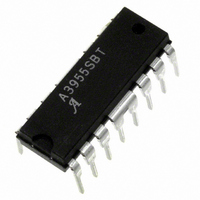A3955SB-T Allegro Microsystems Inc, A3955SB-T Datasheet - Page 9

A3955SB-T
Manufacturer Part Number
A3955SB-T
Description
IC MOTOR DRIVER PWM FULL 16-DIP
Manufacturer
Allegro Microsystems Inc
Datasheet
1.A3955SB-T.pdf
(14 pages)
Specifications of A3955SB-T
Applications
Stepper Motor Driver
Number Of Outputs
1
Current - Output
±1.5A
Voltage - Load
4.5 V ~ 50 V
Voltage - Supply
4.5 V ~ 5.5 V
Operating Temperature
-20°C ~ 85°C
Mounting Type
Through Hole
Package / Case
16-DIP (0.300", 7.62mm)
Motor Type
Full Bridge
No. Of Outputs
2
Output Current
1.5A
Output Voltage
50V
Supply Voltage Range
4.5V To 5.5V
Driver Case Style
DIP
No. Of Pins
16
Lead Free Status / RoHS Status
Lead free / RoHS Compliant
Other names
620-1067
A3955
reference value, resulting in increased motor performance in
microstepping applications.
For a given level of ripple current, slow decay affords the lowest
PWM frequency, which reduces heating in the motor and driver
IC due to a corresponding decrease in hysteretic core losses and
switching losses respectively. Slow decay also has the advantage
that the PWM load current regulation can follow a more rapidly
increasing reference before the PWM frequency drops into the
audible range. For these reasons slow-decay mode is typically
used as long as good current regulation can be maintained.
Under some circumstances slow-decay mode PWM can fail to
maintain good current regulation:
1) The load current will fail to regulate in slow-decay mode
due to a suffi ciently negative back-EMF voltage in conjunction
with the low voltage drop across the load during slow decay
recirculation. The negative back-EMF voltage can cause the load
current to actually increase during the slow decay off time. A
negative back-EMF voltage condition commonly occurs when
driving stepping motors because the phase lead of the rotor
typically causes the back-EMF voltage to be negative towards
the end of each step (see fi gure 3A).
2) When the desired load current is decreased rapidly, the slow
rate of load current decay can prevent the current from following
the desired reference value.
3) When the desired load current is set to a very low value, the
current-control loop can fail to regulate due to its minimum duty
cycle, which is a function of the user-selected value of t
the minimum on-time pulse width t
the PWM latch is reset.
Fast Current-Decay Mode.
is in fast current-decay mode (both the sink and source drivers
are disabled when the load current reaches I
fi xed off-time, the load inductance causes the current to fl ow
from ground to the load supply via the motor winding, ground-
clamp and fl yback diodes (see fi gure 1). Because the full motor
supply voltage is across the load during fast-decay recirculation,
the rate of load current decay is rapid, producing a high ripple
current for a given fi xed off-time (see fi gure 2). This rapid rate of
decay allows good current regulation to be maintained at the cost
of decreased average current accuracy or increased driver and
motor losses.
When V
on(min)
Full-Bridge PWM Microstepping Motor Driver
that occurs each time
PFD
TRIP
0.8 V, the device
). During the
OFF
and
Figure 3 — Sinusoidal Drive Currents
C — Mixed-Decay
A — Slow-Decay
B — Fast-Decay
115 Northeast Cutoff
1.508.853.5000; www.allegromicro.com
Allegro MicroSystems, Inc.
Worcester, Massachusetts 01615-0036 U.S.A.
8















